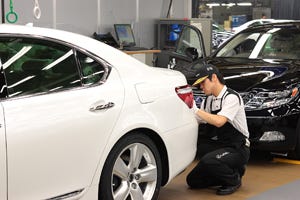Lexus Plant Top of Manufacturing Pyramid in Japan
Plant officials claim the new facility has fused cutting-edge robotics with high-level craftsmanship to create the “ultimate quality.”
June 26, 2009


TOYOTA CITY, JAPAN – Toyota Motor Corp.’s Tahara plant, now in its 31st year of operation, long has set the benchmark for quality in the Japanese auto industry.
And with the launch of the Lexus LS 460 flagship in 2006, the auto maker raised the bar even higher.
In retrofitting the plant’s No.3 line, where the Lexus GS and IS are built alongside the LS 460 and 600h models, Toyota introduced the latest in manufacturing technology.
The list includes super-high-speed/high-precision machining, advanced robotics for handling materials and computerized inspection equipment incorporating state-of-the-art optical measuring equipment.
Plant officials claim the new facility has fused cutting-edge robotics with high-level craftsmanship to create the “ultimate quality.”
Inside the plant’s welding shop are seven sublines where the engine compartment, front and rear floors, right and left side-members, body shell and main body are assembled. In total, 5,000 spot welds are made and verified by computer.
Meanwhile, the plant makes extensive use of laser welding to enhance body rigidity. The process debuted at Tahara in 1989 with the launch of the first-generation LS.

Final inspection line at Tahara plant.
The LS is given six coats of paint, including two base and two clear coats. Spray angle and stroke are programmed to replicate the best of human painters. Select coats are wet-sanded to create a superior sheen.
With the LS launch, the plant switched to a cartridge system to reduce paint volume.
In final assembly, tolerances for door, trunk and hood fitment are two-thirds more stringent than those for the LS 430, the LS 460’s predecessor. Compared with the first-generation LS, gaps have been reduced on average from 0.02 ins. (0.5 mm) to 0.01 ins. (0.2 mm).
In the engine compartment, all moving parts are set into position with the aid of 3-dimensional measuring equipment to reduce friction.
Engine assembly – the shop makes both 4.6L and 5.0L V-8s for the LS – is carried out in a virtual clean room. Operators must pass through an air shower before entering the shop.

Lexus engine assembly.
All completed engines are subjected to both warm and cold tests at speed levels ranging from 550 rpm to 4,000 rpm. Other tests include idling stability and variable valve-timing. The auto maker has installed a microphone in the engine compartment of each car to certify it meets standards for noise, vibration and harshness.
The engine line does everything from casting and machining to assembly. Included are six sublines on which Toyota produces oil pans, intake manifolds and other components.
At the start of a highly automated final inspection line is a glass-enclosed control room with five large displays showing the position and status of each car in the plant and, more importantly, identifying any problems. Each car is numbered.
Upon entering the line, which employs 100 inspectors and takes three hours to pass through, a robot shoots 1,300 photos of the body’s surface. Those are analyzed by computer to determine if there are any marks, including defects barely visible to the human eye. Potential problems are red-flagged for human inspectors, who fix them, if necessary, before signing off.

Engine undergoes testing before installation.
An additional battery of cameras photographs door, trunk, hood and headlamp fittings. A similar process is in place for wheel alignment.
Next up is a battery of running, stopping and turning tests. A microphone installed in the car detects noise levels.
At the end of the line are two short lines to validate braking, exhaust gas and electronic controls, including cruise and millimeter-wave controls.
All finished cars are taken to a 2.5-mile (4-km) oval track where some 65 items are checked including whether brakes provide the appropriate feedback, the transmission shifts smoothly and brake, transmission-gear and road noise is kept within tolerances.
LS suppliers subject each component to similar stringent inspection one by one before shipping to Toyota. Suppliers include JTEKT Corp. (variable-ratio steering system); Denso Corp. (4-zone climate-control system and thin liquid crystal display); Toyota Boshoku Corp. (memory seats); and Aisin AW Co. Ltd. (8-speed automatic transmission).
The Tahara plant opened its doors in January 1979. With the LS launch in 1989, it opened the industry’s first dedicated Quality Satisfaction line.
Within the plant’s 900-acre (364-ha) grounds are three vehicle assembly shops and two engine plants. Lines One and Two produce the Toyota Land Cruiser, Prado, Hilux Surf and RAV4.
About the Author
You May Also Like



